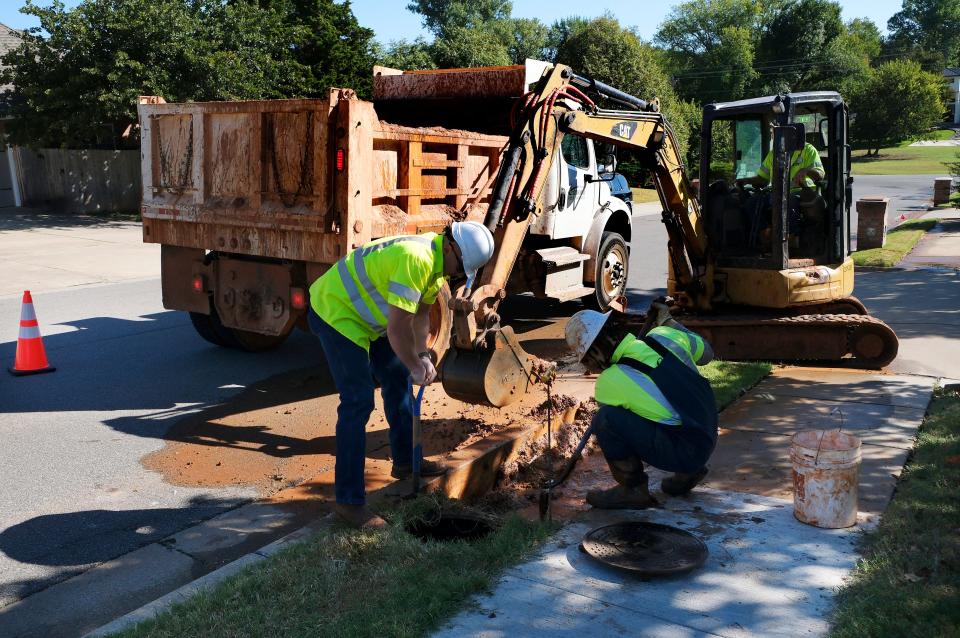The EPA wants to eliminate all lead pipes in 10 years. Here's what OKC has left to fix
The federal government is proposing the complete elimination of lead pipes throughout the country, a staggering task that will cost billions of dollars to ensure safe drinking water.
The Environmental Protection Agency announced last month a goal of replacing 100% of lead pipes within a decade.
Lead was a common pipe material before the 1980s, when federal regulators began implementing strong restrictions on lead pipes and fixtures. According to the EPA, buildings and homes older than 1986 can still have lead service lines that connect a building's plumbing system to the main water supply line.
Although Oklahoma City's water system has no main lines made of lead, city workers have found and replaced an average of 27 lead service lines (LSLs) each year since 2008. Like many other water systems, OKC replaces lead service lines only if they're found during a service call or while working on an adjacent water main.
Oklahoma City considers a "service line" to be the pipe between the main line and a customer's meter. Anything beyond the meter, including pipes inside your home or building, is considered private property. If a water utility wants to tap into federal funding, however, the entire lead pipe must be replaced even if it's between the meter and the house. The city is just starting to develop a process for this work.
There is no safe level of lead in drinking water
Decades of scientific research shows there is no safe level of exposure to lead in drinking water, especially for children.
Lead exposure can cause damage to vital organs like the brain and kidneys, and can interfere with the production of red blood cells. In children, even at low levels, lead exposure can cause learning and behavioral problems. In adults, health effects include risk of heart disease, high blood pressure, kidney or nervous system problems and cancer.
The EPA said it's strengthening the rule after 30 years of regulation because the current restrictions are "insufficient to protect public health."

In 2021, the Centers for Disease Control and Prevention reported 91 cases of elevated lead levels among Oklahoma residents. The prevalence rate is below the national average, but many states did not report data to the CDC.
In 2021, EPA required water systems to develop an inventory of LSLs and notify customers if they have one leading to their property. The inventory search also includes lines made of galvanized metal that can absorb lead from upstream sources.
"The replacement plan will provide for the replacement of every service line located between the city’s water main and the meter, identified as lead or galvanized requiring replacement," said Jasmine Morris, public information and marketing manager for the city's utilities department. "The start, and speed, of line replacements will be dependent upon the number of total lines identified in the inventory that require replacement."
What to know about the EPA's proposed lead pipe rule
If the proposed rule is implemented, the vast majority of water systems across the country would have to identify and replace lead service lines within a decade. The EPA also wants to improve water sampling at taps known to have lead service lines.
The rule also would lower the "lead action level," which is the amount of lead discovered at a tap before the city would have to inform residents and take action to replace upstream pipes that contain the toxic heavy metal.
Water systems found to exceed the lead action level multiple times would have to conduct additional outreach with customers and make water filters available to all customers.
It's not known how many lead service lines exist within Oklahoma City's water system. Morris said the utility department is currently taking a physical inventory of lines, focusing on areas that were developed when lead pipes were commonly used.
"Until the inventory process is complete, we will not have an accurate count of public and private service lines that contain lead," Morris said. "Each line inspection will be recorded and uploaded into a software program for further analysis and asset management purposes."
Who will be paying to repair water pipes?
The Biden Administration's 2021 infrastructure law includes $50 billion for upgrades to the nation's drinking water and wastewater infrastructure. That funding includes $15 billion to cover lead service line replacement and another $11.7 billion that was earmarked to help states to comply with another program, the Safe Drinking Water Act.
The new rule also would affect hundreds of rural water districts throughout the state. Brandon Bowman, state programs director for the Oklahoma Rural Water Association, said many of the districts serve towns that were built a century ago when lead pipes were still widely used.
But Bowman said one of the biggest issues to be resolved is exactly how far a utility must go.
"The traditional dividing line on ownership and responsibility is at the meter. Systems are facing this conundrum of, well, how do we replace something we don't own?" Bowman said. "Lead service lines need to be replaced. Any amount of lead is toxic. But trying to figure this out is a tough nut to crack."
For example, how would a utility replace privately owned lead lines if they don't get the owner's permission to begin work?
"It's going to take some thinking, some cooperation, to resolve that part of the issue," Bowman said.
The EPA is accepting written comments from the public until Feb. 5. The agency also will hold a virtual public hearing on Jan. 16, at which the public will be invited to provide verbal comments.
This article originally appeared on Oklahoman: EPA proposes rule to replace all utilities lead water pipes

